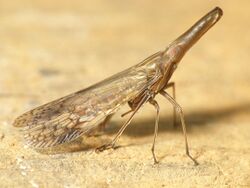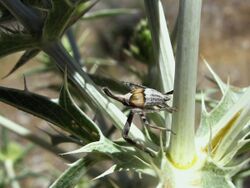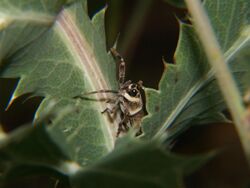Biology:Dictyopharidae
| Dictyopharidae | |
|---|---|

| |
| Dictyophara species | |
| Scientific classification | |
| Domain: | Eukaryota |
| Kingdom: | Animalia |
| Phylum: | Arthropoda |
| Class: | Insecta |
| Order: | Hemiptera |
| Suborder: | Auchenorrhyncha |
| Infraorder: | Fulgoromorpha |
| Superfamily: | Fulgoroidea |
| Family: | Dictyopharidae Spinola, 1839 |
Dictyopharidae is a family of planthoppers, related to the Fulgoridae. The family comprises nearly 760 species in more than 150 genera[1] which are grouped into two subfamilies, Dictyopharinae and Orgeriinae.
Description
Like all other fulgoroids, they have the antennae arising on the side of the head below the compound eye (not between the eyes as in the Cicadoidea). Many species have an elongated frons. Those that do not have this elongation may have 2 or 3 carinae (keels). The median ocellus is absent.[2]
Diversity
Genera are placed in two subfamilies:
Dictyopharinae
Authority: Onuki, 1901; selected genera include:
- Dictyophara Germar, 1833
- Dictyotenguna Song & Liang
- Miasa Distant, 1906
- Neodictya Synave, 1965
- Rhynchomitra Fennah, 1944
- Scolops Schaum, 1850
- Thanatodictya Kirkaldy, 1906
Orgeriinae
Authority: Fieber, 1872; the following genera, in four tribes, are included by BioLib.cz:[3]
- Almanini Kusnetzov, 1936
- Almana Stål, 1861
- Bursinia A. Costa, 1862
- Cnodalum Emeljanov, 1978
- Coppa Emeljanov, 1969
- Coppidius Emeljanov, 1969
- Haumavarga Oshanin, 1908
- Iphicara Emeljanov, 1978
- Mesorgerius Kusnezov, 1933
- Nymphorgerius Oshanin, 1913
- Orgamarella Emeljanov, 1969
- Parorgerioides Bergevin, 1928
- Scirtophaca Emeljanov, 1969
- Sphenarchus Emeljanov, 2003
- Tachorga Emeljanov, 1969
- Tigrahauda Oshanin, 1908
- Tilimontia Emeljanov, 1969
- Colobocini Emeljanov, 1969
- Colobocus Emeljanov, 1969
- Orgeriini Fieber, 1872
- Acinaca Ball & Hartzell, 1922
- Almanetta Emeljanov, 1999
- Aridia Ball & Hartzell, 1922
- Austrorgerius Woodward, 1960
- Deserta Ball & Hartzell, 1922
- Orgamara Ball, 1909
- Orgerius Stål, 1859
- Ticida Uhler, 1891
- Ticrania Emeljanov, 2006
- Timonidia Ball & Hartzell, 1922
- Yucanda Ball & Hartzell, 1922
- Kumlika Oshanin, 1912
- Ototettix Oshanin, 1912
- Ranissini Emeljanov, 1969
- Elysiaca Emeljanov, 1969
- Parorgerius Melichar, 1912
- Phyllorgerius Kusnezov, 1928
- Ranissus Fieber, 1866
- Sphenocratus Horváth, 1910
Unplaced and fossil taxa
The following genera are incertae sedis:
- Mitropodes Baptista, Ferreira & Da-Silva, 2006
- Mozzela Baptista, Ferreira & Da-Silva, 2006
A number of species are known from the fossil record, which reaches back to the Santonian age of the Late Cretaceous. The oldest fossil, Netutela annunciator belonging to the extinct dictyopharine tribe Netutelini, was described from Taymyr amber on the Taymyr Peninsula of Russia.[4] Younger amber fossils include the amber genus Alicodoxa described from Eocene Baltic and Rovno ambers[5] Compression fossil species include the Ypresian Limfjordia breineri from the Fur Formation in Denmark and the Priabonian Florissantia elegans from the Florissant Formation, Colorado.[4]
References
- ↑ Song, Zhi-Shun; Ai-Ping Liang (2011). "Two new genera and two new species of Oriental dictyopharid planthoppers (Hemiptera: Fulgoromorpha: Dictyopharidae) from Sri Lanka and southern India". Zootaxa 2740: 24–34. doi:10.11646/zootaxa.2740.1.2. http://www.mapress.com/zootaxa/2011/f/z02740p034f.pdf.
- ↑ Borror, DJ; Triplehorn, CA; Delong, DM (1989). Introduction to the Study of Insects, 6th Edition. Saunders College Publishing. ISBN 0-03-025397-7.
- ↑ BioLib.cz: Orgeriinae Fieber, 1872 (retrieved 10 July 2021)
- ↑ 4.0 4.1 Szwedo, J. (2008). "A new tribe of Dictyopharidae planthoppers from Eocene Baltic amber (Hemiptera: Fulgoromorpha: Fulgoroidea), with a brief review of the fossil record of the family". Palaeodiversity 1: 75–85. https://www.researchgate.net/publication/228505811.
- ↑ Emeljanov, A. F.; Shcherbakov, D. E. (2011). "A new genus and species of Dictyopharidae (Homoptera) from Rovno and Baltic amber based on nymphs". ZooKeys (130): 175–184. doi:10.3897/zookeys.130.1775. PMID 22259275.
External links
Wikidata ☰ Q1439261 entry
 |




